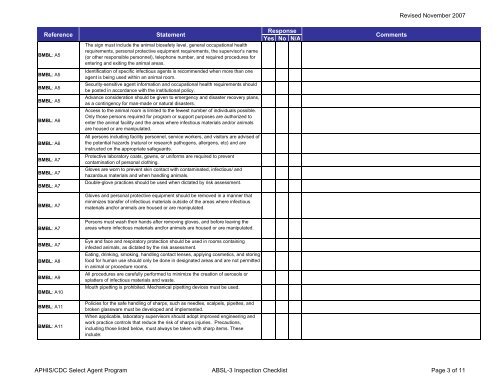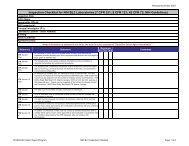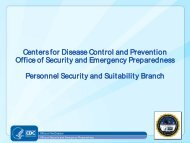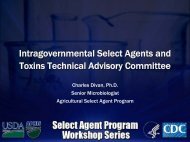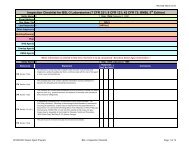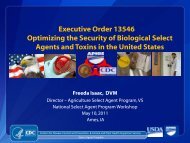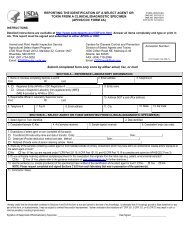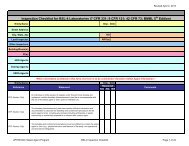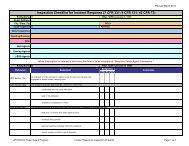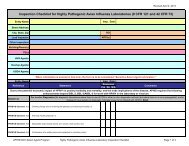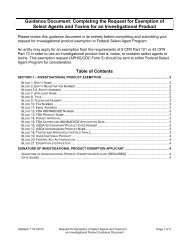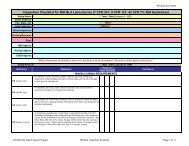Inspection Checklist for ABSL-3 Laboratories - Select Agent Program
Inspection Checklist for ABSL-3 Laboratories - Select Agent Program
Inspection Checklist for ABSL-3 Laboratories - Select Agent Program
You also want an ePaper? Increase the reach of your titles
YUMPU automatically turns print PDFs into web optimized ePapers that Google loves.
Revised November 2007ReferenceBMBL: A5StatementThe sign must include the animal biosafety level, general occupational healthrequirements, personal protective equipment requirements, the supervisor’s name(or other responsible personnel), telephone number, and required procedures <strong>for</strong>entering and exiting the animal areas.ResponseYes No N/ACommentsBMBL: A5BMBL: A5BMBL: A5BMBL: A6Identification of specific infectious agents is recommended when more than oneagent is being used within an animal room.Security-sensitive agent in<strong>for</strong>mation and occupational health requirements shouldbe posted in accordance with the institutional policy.Advance consideration should be given to emergency and disaster recovery plans,as a contingency <strong>for</strong> man-made or natural disasters.Access to the animal room is limited to the fewest number of individuals possible.Only those persons required <strong>for</strong> program or support purposes are authorized toenter the animal facility and the areas where infectious materials and/or animalsare housed or are manipulated.BMBL: A6All persons including facility personnel, service workers, and visitors are advised ofthe potential hazards (natural or research pathogens, allergens, etc) and areinstructed on the appropriate safeguards.BMBL: A7BMBL: A7BMBL: A7Protective laboratory coats, gowns, or uni<strong>for</strong>ms are required to preventcontamination of personal clothing.Gloves are worn to prevent skin contact with contaminated, infectious/ andhazardous materials and when handling animals.Double-glove practices should be used when dictated by risk assessment.BMBL: A7Gloves and personal protective equipment should be removed in a manner thatminimizes transfer of infectious materials outside of the areas where infectiousmaterials and/or animals are housed or are manipulated.BMBL: A7Persons must wash their hands after removing gloves, and be<strong>for</strong>e leaving theareas where infectious materials and/or animals are housed or are manipulated.BMBL: A7BMBL: A8BMBL: A9BMBL: A10Eye and face and respiratory protection should be used in rooms containinginfected animals, as dictated by the risk assessment.Eating, drinking, smoking, handling contact lenses, applying cosmetics, and storingfood <strong>for</strong> human use should only be done in designated areas and are not permittedin animal or procedure rooms.All procedures are carefully per<strong>for</strong>med to minimize the creation of aerosols orsplatters of infectious materials and waste.Mouth pipetting is prohibited. Mechanical pipetting devices must be used.BMBL: A11BMBL: A11Policies <strong>for</strong> the safe handling of sharps, such as needles, scalpels, pipettes, andbroken glassware must be developed and implemented.When applicable, laboratory supervisors should adopt improved engineering andwork practice controls that reduce the risk of sharps injuries. Precautions,including those listed below, must always be taken with sharp items. Theseinclude:APHIS/CDC <strong>Select</strong> <strong>Agent</strong> <strong>Program</strong> <strong>ABSL</strong>-3 <strong>Inspection</strong> <strong>Checklist</strong> Page 3 of 11


